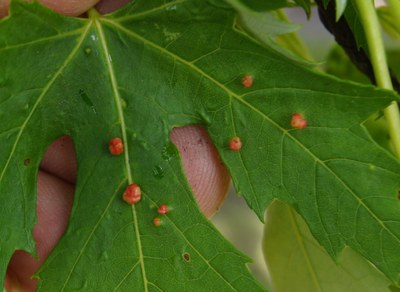Leaf galls already observed
Printed in the NDSU Crop and Pest Report, June 1, 2017.
A number of different pests – insects and mites – produce a variety of galls on tree leaves. We normally don’t observe galls until later in the summer – late June through August. This year, I’ve already observed the galls produced by the maple bladder gall mite (see photo). These tiny red growths are generally harmless to the tree, unless they are extremely numerous. And that can be said of most of the leaf galls that we see on trees.
Galls are produced by the trees in response to early-season feeding from the pest. Then, the pest will generally use the gall as protection – a sort of ‘home’ – while it completes its life cycle. The time to use a pesticide to prevent new damage was a month ago – as leaves were opening and the pests were still exposed. At this point, the gall provides quite a bit of protection, so applying a pesticide now will have very limited effectiveness at controlling what’s there, or for preventing new infestations. By the time we see the gall the damage is done and the pest may already be gone.
The good news is that damage is generally minimal. Trees can lose up to 25% of their leaf tissue without experiencing any stress. Unless the galls cover more than a quarter of the leaf surface, they won’t be causing any major damage to the trees. The only time that I observed damage that high from gall-forming pests was in a number of yards that had heavy applications of insecticide to control insects in the lawn. My hypothesis is that the chemical also killed a number of the predator insects and mites, resulting in a spike in the gall-forming insects.


